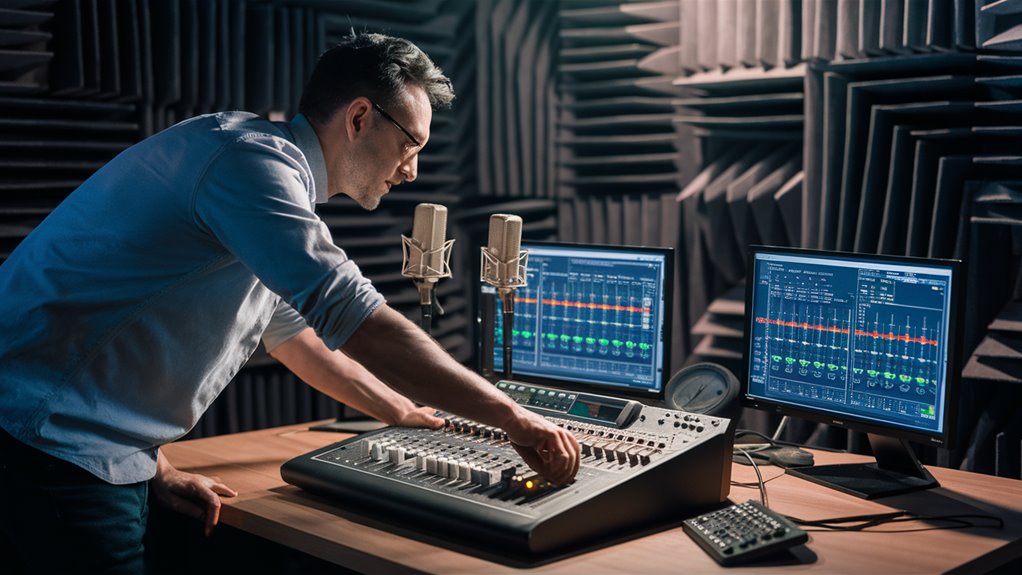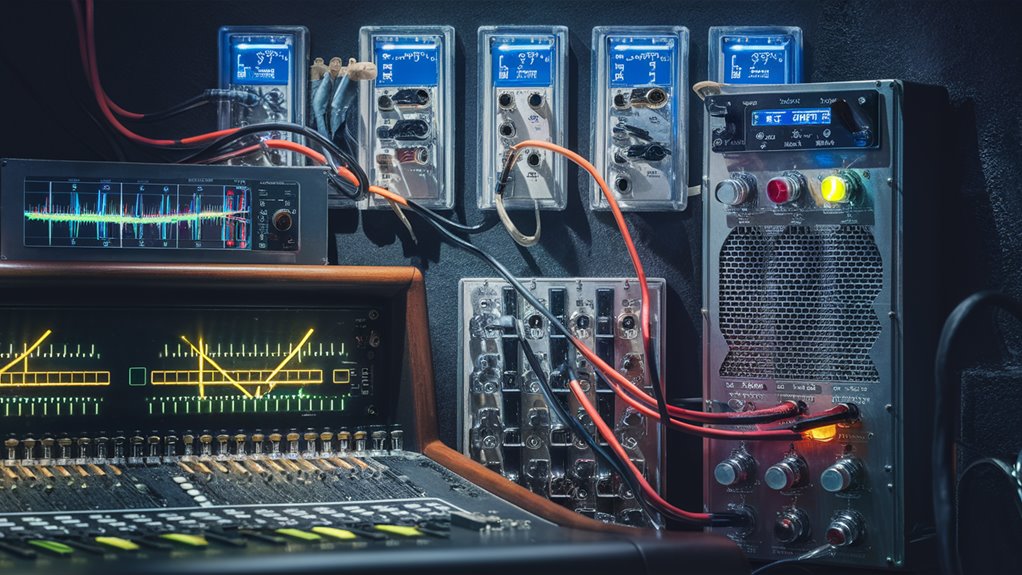Simple Karaoke Sound Setup Guide: Gear Setup & Best Settings

Key Gear Setup
It’s key to start with the right gear for a top karaoke sound. A 4+ channel pro mixer with 300W RMS strong speakers are key. Set the speakers at 45 degrees for the best sound all over your space.
Good Microphones & Their Settings
Pick dynamic cardioid mics with 50Hz-15kHz sound range for clear singing sounds. They help lower noise which is common in karaoke spots.
Advanced Sound Fixes
EQ Tweaks
- Raise the 2.5-5kHz to make vocals clear
- Smooth Karaoke Experience
- Cut sounds under 100Hz to stop unwanted low noise
- Set compression to a 4:1 ratio for even sound levels
- Add effects up to 15-20% for depth in sound
Fixing Room Sound
Good sound setup changes plain spots into top karaoke places:
- Put sound panels at first echo points
- Set bass traps in corners
- Aim for 0.8-1.2 second echo time
- Check room sound and fix as needed
Extra Tuning Tricks
- Set system levels best for low noise
- Stop feedback with good speaker and mic spots
- Look after and fix gear often
- Check and fix sound levels when playing for good sound
Needed Karaoke Gear Parts
Key System Needs
A pro karaoke setup needs key gear parts to work well, giving good sound and strong performance.
The next parts are key for a pro karaoke set.
Sound Control Center
The heart of the system needs a pro mixer with at least 4 channels to handle the sound. This special center helps control sound well and lets singers switch smoothly.
Sound Output System
- Powered speakers (at least 300W RMS each)
- Can cover spaces up to 2000 square feet
- Two wireless mics on different waves
- Pro stage screen for singer feedback
Music Handling
Digital play systems must have:
- Pro karaoke set or PC with special software
- Works with many file types (MP3+G, CDG, MP4)
- Pro XLR outputs for best links
- Big storage for many songs
Technical Parts
- Top XLR wires for clear sound pass
- Strong gear holder for secure gear keeping
- Digital sound machine with:
- Smart feedback stop
- Custom EQ settings
- Live sound better tools
Safety and Sure Features
- Rush block setups
- Backup power options
- Extra sound paths
- Top-grade link spots
This full setup makes sure of top sound quality, steady performance, and pro-level fun for any spot size or job.
Picking the Right Microphones
Picking the Right Microphones for Pro Sound
Key Mic Features for Top Audio
Dynamic mics made for live singing are best for top sound quality.
These mics handle noise and touch sounds better than other kinds, making them great for lively shows.
Main Tech Points
Cardioid sound shapes are key for best sound grab, blocking unwanted noise from back and sides while keeping singing sounds clear.
The best sound range of 50Hz to 15kHz gets voice sounds just right while stopping bad low sounds.
Build and Features
Pro mics need metal builds and inner shock setups for long life.
Built-in pop filters cut sudden sounds and wind noise, while 24-bit/48kHz digital waves in wireless setups give studio-like sound with more use ways.
System Links and Settings
Twin matching mics let singers do duet shows with the same sound quality.
Well-made XLR links with gold-plated connectors make sure of best signal clearness, cutting interference and keeping sound top-grade through the sound path.
Making EQ Settings Best
Best Guide to Making EQ Settings Right for Pro Sound
Base EQ Rules
Top-grade sound quality starts with right EQ ways.
Start with a flat EQ setup and make smart changes based on the room sound.
The best way puts focus on smart sound cuts more than raising, which cuts feedback issues and sound twist.
Vocal EQ Best Settings
The key vocal sound range of 2.5kHz to 5kHz needs special care for best clearness.
Put right sound boosts in this range and apply a cut under 100Hz to stop low sound shake.
A focused cut in the 200-300Hz sound range rightly cuts muddy sounds that can mess with voice clearness.
Song Track Better Points
Smart EQ handling needs separate fixes for music and voice tracks.
Create best voice space by putting smart sound cuts in the song part, especially around the 3kHz range.
Keep separate EQ channels for full control, letting right changes to both music and mic sounds without messing the full sound balance.
Key Sound Changes
- Low-end (20-100Hz): Cut to lower unwanted shake
- Lower-mids (200-300Hz): Narrow cut for clearness
- Upper-mids (2.5-5kHz): Boost for voice feel
- Music part (3kHz): Cut to make space for voice
- High-end (6kHz+): Fine-tune for shine
Room Sound and Sound Fixing
Pro Room Sound and Sound Fixing Guide

Knowing Room Sound for Best Sound
Room sound is key for getting pro-level sound.
A full sound check of your space is needed to find sound problems and put in right fixes.
Room Check Basics
Start with a full sound check using pink sound through your sound gear. Map spots where:
- Sound bounces too much
- Sound softening happens
- Long sound waves form between flat walls
- Quick echo shows
- Bass sounds gather
Smart Sound Fixing Ways
Bass Handling
Put bass traps in room corners to control low sound build-up. This first step stops muddy sound and makes sure of clear, tight bass all through the space.
Reflection Control
Put sound panels at first echo spots:
- Side walls between speakers and listeners
- Ceiling spots above where you listen
- Back wall behind the audience
Sound Spreading
Use spreader panels on flat walls to stop quick echo and make a more even soundfield. Smart spots help keep natural room feel while handling problem echoes.
Checking and Making Echo Best
Check your room’s echo time, aiming for 0.8-1.2 seconds for best voice clearness.
Put in more treatment as needed:
- Sound soaking materials
- Strategic rug spots
- 호치민 황제투어
- Sound softening curtains
- Pro-level sound panels
These focused changes will make an ideal sound setting for top-level sound.
Sound Working and Effects
Pro Sound Working and Effects for Karaoke Systems
Key Sound Chain Parts
Sound working and sound effects are key parts in modern karaoke sound work, changing basic voice inputs into pro-level output.
The smart use of these tools makes a deep, studio-like feel for singers and people watching.
Main Working Ways
The base starts with noise stopping, set just above room noise levels to cut unwanted background sounds.
Dynamic squeezing follows, using a pro 4:1 ratio with best start times to keep sound levels even across different singing strengths.
Equalization (EQ) is key, with focused sound changes including smart cuts in the 200-300Hz range to stop muddiness while bettering the key 2-4kHz presence band for max voice clearness.
Top Effects Use
Space sound work lifts the sound feel through well-made echo algorithms.
Pro plate and hall plays, set with 1.8-2.2 second fade times, make deep feel while keeping natural voice parts.
Extra change effects including chorus and right-timed delays (15-30ms) give more depth when needed. Pro use keeps a -6dB space buffer, making sure of top sound quality and keeping key dynamic range all through the sound chain.
Handling Feedback and Noise
Handling Feedback and Noise in Pro Sound Systems
Stopping Sound Feedback
Sound feedback control is a main part in pro sound work, especially for karaoke systems.
Smart speaker spots play a key part, with main speakers set before mic catch patterns and turned 45 degrees out to lower sound bounce paths.
Top Feedback Spotting and Control
Sound range tech lets exact spotting of feedback sounds, letting for focused fixes through sound EQ changes.
The use of the “3-to-1 rule” in monitor spots makes sure of best sound help while keeping feedback in check.
31-band graphic sound adjusters give detailed control over problem sound ranges, letting max sound rise before feedback happens.
Noise Handling and Sound Making Best
RF noise stopping needs full sound wave planning and smart wireless channel picks to keep away from clashes with broadcast waves and local senders.
EMI lower ways include putting iron loops on wire runs and keeping right gear ground ways.
Sound fixing mixed with right gain structure handling lets higher monitor levels while keeping signal clear and stopping unwanted feedback circles.
Sound Mixing Best Ways
Pro Sound Mixing Guide for Karaoke Systems
Key Mixing Needs
Sound mixing basics are the base of any pro karaoke sound system.
Right signal handling and even sound levels make the base for great voice shows.
Reference Level Setup
The voice channel base should be set at 0dB as the main reference point.
Set the back song 2-3dB under this level to make best space.
High-pass filtering at 100Hz stops unwanted low sound while keeping voice clear.
Top EQ and Squeezing Settings
Smart equalization is key in pro sound quality.
Apply smart cuts in the 200-400Hz sound range to stop muddiness, while raising the 2-5kHz range makes voice feel better.
Use dynamic squeezing with a 3:1 ratio on song tracks to keep energy levels even.
Effect Handling and Show Control
Echo care should be kept under control at 15-20% wet signal part for pro depth.
Keep tight gain stage rules with -6dB space before the master bus.
Real-time slide control during live shows makes sure the singer stays in front in the mix while keeping a perfect balance with the back song.
Watching and Level Handling
Pro gain build through the signal path promises top sound quality.
Active level handling during shows keeps voice on top of back tracks while keeping dynamic range and clearness.
